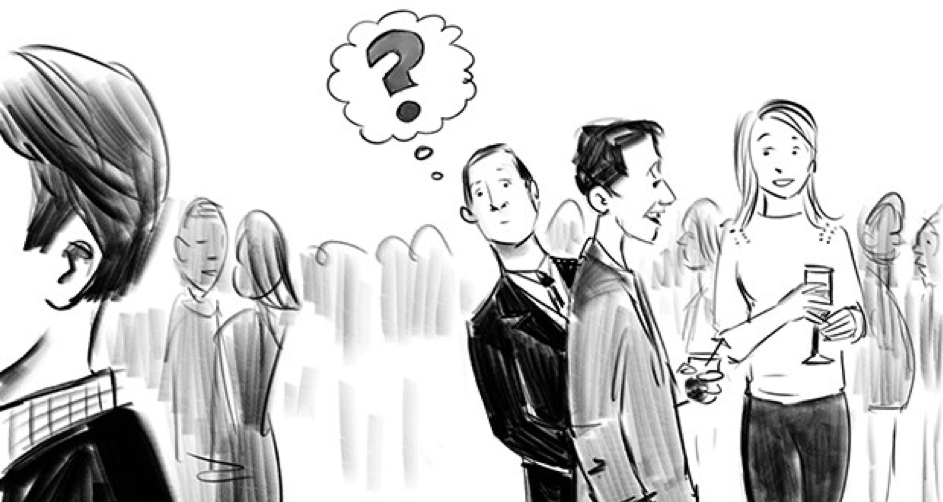
I always thought I had issues with my hearing. Years of playing in bands and blasting thrash metal through my headphones was likely going to do some damage, but when I realised how often I was asking people to repeat themselves I thought I’d organise a hearing test. My GP referred me to an audiologist at Belfast City Hospital where I sat in a booth and pressed a little button every time I heard a beep. I’ve been a musician for 17 years and I’m generally pretty competitive, so I took my ability to hear these beeps quite seriously. I did a little fist–bump to myself when the specialist told me I had the auditory equivalent of 20/20 vision, but I still wasn’t convinced. I was sure my hearing in one ear was better than the other, and I was still asking friends to repeat themselves all the time – especially in the bar or walking down the street.
Being the overly–analytical type, I took the opportunity to ask an ENT consultant about this while preparing for nose surgery. He immediately recognised the symptoms as Hidden Hearing Loss (HHL), a condition caused by a disconnection of auditory nerves which specifically operate in high levels of sound. Of course, this isn’t picked up on normal hearing tests as the beeps played are at a quiet volume. Specifically, HHL causes individuals to struggle with speech in noisy environments – it’s an issue of identifying detailed auditory stimuli among general noise. Finally, I have proved that it’s not caused by being very tall and “far away from people’s mouths”.
Reading about HHL got me thinking about a psychological effect I first heard about during my undergrad – “The Cocktail Party Effect”, first defined by Colin Cherry in 1953. Essentially, this is a theory of selective attention used to explain why our attention to one conversation may be distracted by another, attributing the effect not to the content of the information (what is being said), but on the physical characteristics of any message, such as clarity or tone of voice. This suggests that even though information is stored, albeit very briefly, in short–term memory, it is only after filtering that it is processed for meaning and actually understood.

Scheherazade (image owner) The Cocktail Party Effect [digital image]. Retrieved from head–fi.org / cropped from original.
This finding had important implications when applied to high–pressure job roles. For example, in air traffic control, decisions could be made on possibly irrelevant or inaccurate information, rather than being prioritised according to meaning and importance. Cherry went on to work with Donald Broadbent, a WWII pilot turned cognitive psychologist. The pair developed a series of experiments on dichotic listening and found that filtering is also affected by expectation. In one such experiment, participants were asked to listen to different sets of numbers presented simultaneously to each ear. In some cases, they were instructed which ear (the information channel) they would be asked about first; in others no instructions were given. The results showed that when people know which ear is receiving the stream of information they will be asked for first, they switch attention to that ear, and the information that enters the other ear isn’t always accurately retrieved from memory. In all cases, the information that people chose or were asked to remember first seemed to be processed more accurately than the later material; it was thought this might be due to parts of the information being lost from the short–term memory store before the participant tried to retrieve it.
After being appointed director of the UK Medical Research Council’s Applied Psychology Unit (APU), Cherry saw his new appointment as an opportunity to continue his work on attention, widening the scope of his research and refining the theory. One phenomenon Cherry discovered was that when an overheard conversation includes information that has some kind of special significance for a person – such as a personal name – the attention is switched towards that conversation, and away from the one previously attended to.
Further dichotic listening experiments at the APU bore out Cherry’s findings: attention is filtered by physical characteristics but also by meaning, using feedback from memory stores, prior experience, and expectations. The sound of a siren, for instance, would divert attention on to that stream of sound. This suggests that information is in some way understood before being selected for attention. Broadbent realised that his filter model needed modification but was pleased to have made the changes. As a scientist, he felt that all scientific theories are temporary, derived from the evidence available at the time, and thus susceptible to change in the light of new evidence; this is how science progresses.
Broadbent’s work in the APU contributed to their research into attention with a widening range of applications. One focus of research looked at how pilots prioritised information in the cockpit and what design changes would aid this. Taking a similar approach to his work on dichotic listening, it seemed to Broadbent that pilot error was often made when there were too many sources of incoming information. For example, the lever for pulling up the wheels was identical to the one for pulling up the flaps, and the dials in the cockpit often looked identical and were hard to read during the stress of flight combat.

Thomas, K. (image owner). General Dynamics F–111A cockpit from the 1960s. Retrieved from defco.org.
UX practitioners strive to improve performance–limiting designs. However, I feel that a lot of us would benefit from a lesson in the limitations of attention and performance. I’m a big advocate of scientific research influencing logic and methodology within creative industries. I grind my teeth when I see a system or website with too much information in front of me. This is perhaps because an important factor in understanding how the brain interprets design, memory processing and attention, is the psychological process of visual perception and focused visual attention. Vision is probably our most important sense modality; we can study a wider range of issues in the visual than in the auditory modality.
One of my favourite examples of psychology influencing design relative to visual perception is that of Dazzle Camouflage. Dazzle painting emerged in the 1910s as a solution to combat the sinking of allied ships by German U–Boats, and conventional high–similarity camouflage just doesn’t work in the open sea. Conditions like sky colour, cloud cover and wave height change all the time, not to mention the fact that there’s no way to hide all the smoke left by the ships’ smoke stacks.
The strategy of this high–difference dazzle camouflage was not about invisibility. It was about disruption, confusion and altered perception. In order to distort the perceived heading of a ship, this pattern was used to make use of a pictorial depth cue: the texture gradient. At the time of both World Wars, torpedoes could only be fired line–of–sight, so rather than firing at where the ship was in that moment, torpedo gunners would have to predict where the ship would be by the time the torpedo got there. Rather than attempting to hide individual units, it was claimed that this patterning would reduce the perception of their range, heading, size, shape and speed, and hence reduce losses from torpedo attacks (Scott–Samuel, Baddelley, Palmer and Cuthill, 2011).

Anon. Photograph of the USS West Mahomet in dazzle camouflage, 1918 [digital image]. Courtesy of US Naval Historical and Heritage Command, NH 1733. Retrieved from Wikipedia.
The cause of my hearing issue went undiagnosed because the specialist used a standardised testing method that did not entirely align with the context of the problem I was having. This meant that the effects of information overload were being overlooked. Something similar can happen with web design; reviewing a website’s analytics might show that users are struggling to navigate all the features on a web page, so the designers fiddle with how those elements are configured and displayed. But what the user really needs is to simply have less features fighting for their attention. We can elicit needs like this by learning more about psychology and complementing analytical research methods with qualitative insights about our users. Information overload is certainly something we should be cognisant of. If it can be deliberately used to make expert German U–Boat operators become significantly inaccurate in their objectives, then we have to take care not to let our website designs have the same effect through negligence. Some practical ways for avoiding information overload include:
Reducing information overload is one of many heuristics that we can study and apply to our work if we want to make interfaces more satisfying and easy to use. We are in a fortunate position whereby a huge amount of work has already been done in the field of cognitive psychology, which we can use to inform how we design digital products that work better for people. Taking a scientific approach to UX not only helps you to select more accurate research methods, but also removes any personal bias which may hinder you from changing a design when new insights emerge. Put simply, better research equates to better design.
References
Cherry, E. C. (1953). Some Experiments on the Recognition of Speech, with One and with Two Ears. The Journal of the Acoustical Society of America, 975–79.
Scott–Samuel, N. E., Baddelley, R., Palmer, C., & Cuthill, I. (2011). Dazzle Camouflage Affects Speed Perception. Experimental Psychology, 1–6.